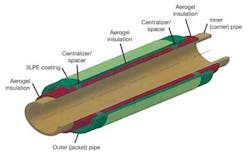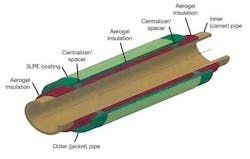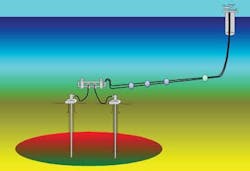Non-chemical products offer effective flow assurance solutions
Keshawa Shukla
McDermott
The"2014 Survey of Offshore Non-Chemical Flow Assurance Solutions" poster, which can be found in this issue of Offshore, provides a comprehensive list of non-chemical solutions to flow assurance issues, and offers updated reference tools and design data for deepwater field development. The poster also provides details on products to manage flow assurance issues arising from wax and hydrate formations, emulsion/foaming/scale formation, slugging; detection of these phenomena; and remediation based on non-chemical solutions. In this endeavor, several leading contractors have made unique contributions by supplying information on their latest products.
Recent technological developments of non-chemical solutions can be applied to manageflow assurance challenges to ensure transport of oil and gas from wells to onshore facilities throughout the field life safely and economically. A combination of different non-chemical solutions can reduce capex and opex significantly and minimize/avoid injection of chemicals, thereby reducing maintenance costs.
The goal here is to present a brief overview of latest developments in non-chemical solutions for managing flow assurance challenges.
Flow assurance review
The oil and gas industry has had enormous success in the flow assurance arena over the past decade. Past experiences fromsubsea field developments have enabled engineers to be more cost-effective in design and operation. Still, flow assurance remains one of the key technical challenges operators face in deepwater.
The most challenging flow assurance issues are the management of wax, hydrate, asphaltene, emulsion/foaming/scale, slugging, and pigging. As water depth increases, issues related to multi-phase flow, production chemistry, pipeline integrity, subsea and surface operations are magnified.
For instance, at the low temperatures of subsea conditions, heavy hydrocarbons may precipitate as wax and asphaltene, and mixing of hydrocarbon fluid and water may form hydrate, restricting the flow. During shutdown of a subsea pipeline, wax/gel may form and solidify when a crude oil cools below its pour point.
Under high pressure conditions, high CO2 and H2S contents in production fluid with water can lead to corrosion. Under high pressure and temperature conditions the relatively large amount of produced water may form scales. Sand production from formation can cause erosion in a subsea pipeline.
At turndown flowing scenarios, liquid build up at a production riser base can cause severe slugging and separation problems in equipment lacking insufficient backpressure. All these issues can cause operational problems from downhole to processing facilities.
In recent years, flow assurance has combined multi-phase flow and production chemistry to manage the interface between reservoir and topsides processing, and is not only based on hydrates, wax, scale, asphaltenes, and corrosion, but also includes network modeling and transient multi-phase simulation to answer the operability of the designed facility and risk management.
Therefore, the subsea systems should be properly designed in a cost effective way, taking into account the above factors starting from concept selection through detailed design of subsea field development. The effective preservation of fluid heat in pipeline systems is one of the most important design parameters, especially for preventing wax and hydrate solid formations/depositions.
Non-chemical solutions
The experience of non-chemical solutions and innovative technology is encouraging. Several non-chemical solutions products and approaches are now available which can be applied to deepwater and ultra-deepwater field developments. The poster also includes properties of non-chemical materials, their recent subsea applications and vendor information. Based on the survey, the available non-chemical solutions can be classified in three categories, 1) active system, 2) passive system, and 3) other innovative methods. A brief account of these systems is given below.
Active systems. These include electrical heating, hot fluid circulation, exothermic processes, line pipe (internal), coiled tubing, bundled pipelines, and through flowlines (TFL). They require input of energy in the form of work or heat. The important characteristics of active systems are the power requirement, circulation fluid types, frequency or continuous usage, increase temperature/pressure, and offset distance. For instance, direct or indirect electrical heating requires energy in the form of electric current to supply heat to a pipe wall. Hot fluid circulation requires heat to elevate temperature of the circulating fluid and work to pump the fluid through the pipeline. The opex for active systems can be offset by reducing the operating costs required to keep production fluid out of hydrate or wax conditions during shutdown operations. Active heating can remediate hydrate plugs safely and can remediate blockages in hours.
Passive systems. These include buried pipe, pipeline wet insulation, pipe-in-pipe (PIP) dry insulation, vacuum insulation, insulated flexible pipe, riser towers, and internal insulation. They do not require an input of energy such as work or heat. Heat retention is achieved by surrounding the pipeline with materials that offer a high resistance to heat transfer with low thermal conductivity. The important characteristics of passive systems are the physical properties such as thermal conductivity, coating thickness, U-value, heat capacity, and density of materials. For instance, thermal insulation systems are wet insulation, dry (pipe-in-pipe) insulation, and pipeline burial. Flexible pipes can be insulated, but their outside diameter is intrinsically large and limits the amount of required insulation. Costs for passive insulation systems involve capex. A combination of pipeline wet insulation, burial, and trenching can provide a cost effective passive system. The insulation system can impact on-bottom stability, cost of installation, and field-joint design. Riser insulation may impact fatigue.
Displaying 1/2 Page 1,2, Next>
View Article as Single page


